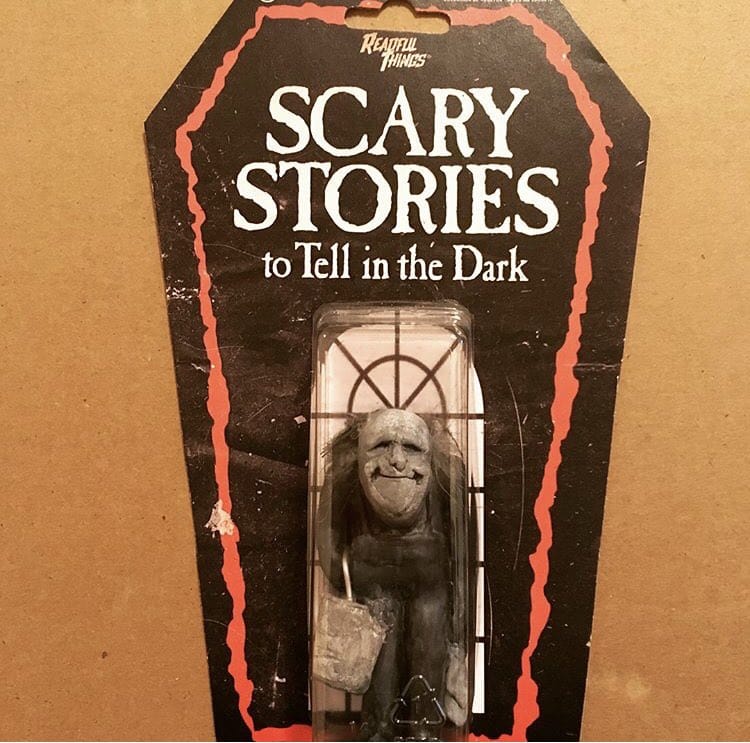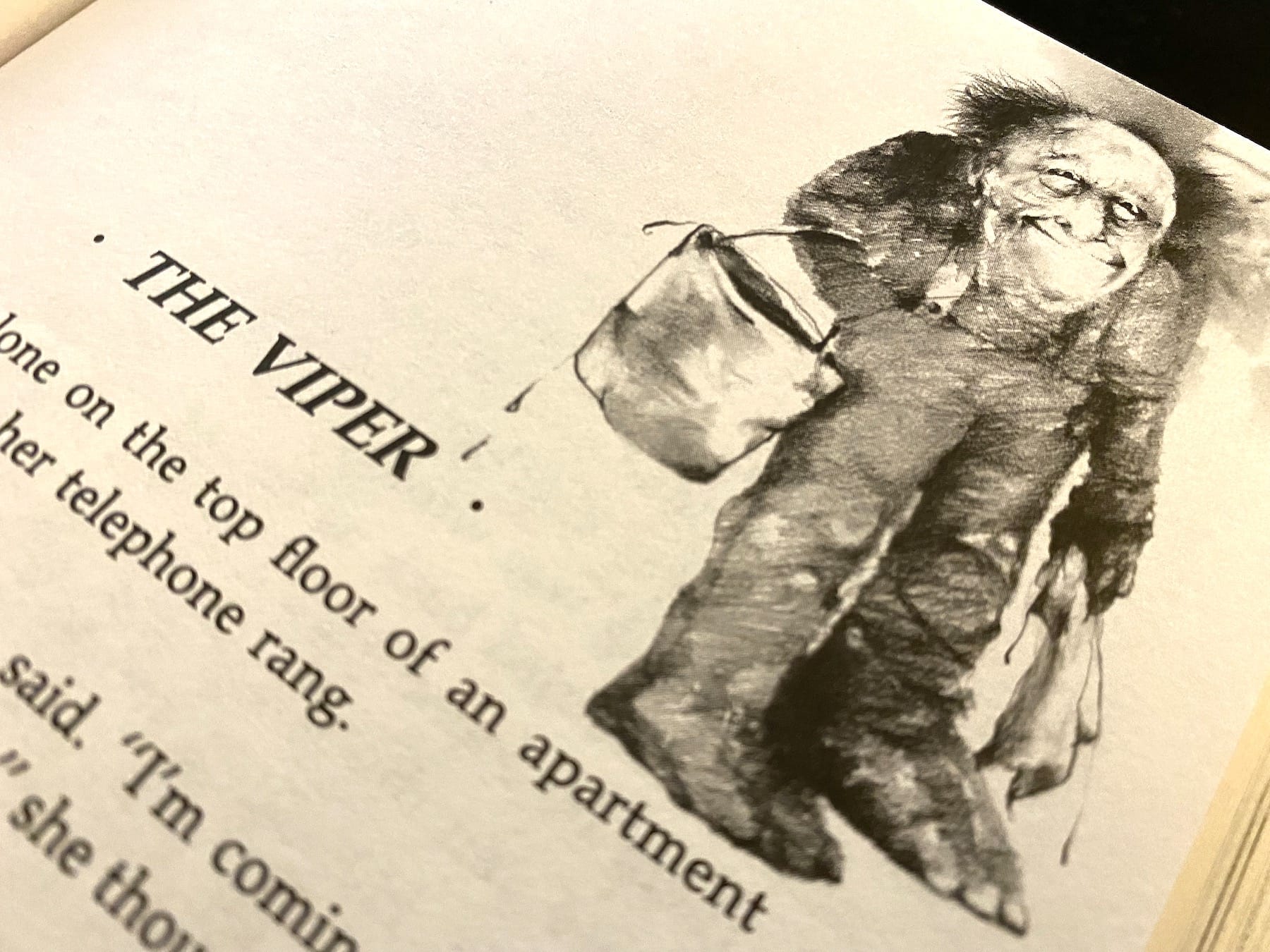I made a documentary about Scary Stories to Tell in the Dark. (Now available to watch.) The three books consisted of over 80 stories of folklore and urban legends. It was impossible to appropriately address each and every story in a single documentary. This website, in part, is a chance to look at individual stories that I researched, tales in which I learned about their origins and social contexts. It’s a chance to examine stories that I ultimately found to be fascinating in some way or another.
This is The Viper.
When it comes to scary stories for kids, there are some that are supposed to be scary, and there are ones that are supposed to introduce the idea of spookiness while ultimately being safe and kid-friendly. That is certainly the case with a popular folk tale that was featured in the original Scary Stories to Tell in the Dark, The Viper. It’s often called the “vindow viper story” and in fact that is what it was called in many of the previous versions of the tale. Let’s take a look.
The Vindow Viper Story
Here is the version that was included in the original Scary Stories to Tell in the Dark book.
A widow lived alone on the top floor of an apartment house. One morning, her telephone rang. “Hello,” she said. “This is the viper,” a man said. “I’m coming up.”
“Somebody is fooling around,” she thought, and hung up.
A half-hour later, the telephone rang again. It was the same man. “It’s the viper,” he said. “I’ll be up soon.” The widow didn’t know what to think, but she was getting frightened.
Once more, the telephone rang. Again it was the viper. “I’m coming up now,” he said. She quickly called the police. They said they would be right over. When the doorbell rang, she sighed with relief. “They are here!” she thought.
But when she opened the door, there stood a little old man with a bucket and a cloth. “I am the viper,” he said. “I vish to vash and vipe the vindows.”
This story goes back at least to the mid-20th Century, and became circulated even wider in the 1980s after being included in Alvin Schwartz’s Scary Stories books.
A lot of children in the ’80s were even introduced to the tale in the first season of popular kids show G.I. Joe. Here we see it weirdly popping up in Saturday morning cartoons.
Source of “The Viper” Scary Story
Like many such tales, a specific source is lost in time. It has become a common story used in Boy Scouts or other scenarios in which adults want a scary story but one that isn’t too scary.
Alvin Schwartz heard the story from a 14-year-old named Leslie Kush in Philadelphia in 1980. But he also found it mentioned in One Potato, Two Potato: The Secret Education of American Children by Mary and Herbert Knapp (1976). I read the passage of that book that Alvin Schwartz would have checked out of at Firestone Library in Princeton, NJ. In it, the story is told anecdotally, pointing out how scary stories are often given a humorous twist.
As described in One Potato, Two Potato, “The purpose of this book is to show how children use their traditional lore to cope with the stresses of their lives and to learn what it means to be a member of a human society”… to me, that’s exactly what a funny scary story can do. It’s a way to introduce fears and even horror themes and tropes, while also alleviating the truly fearful part of it.
Although at a certain point it is important to let children be scared, it is also important for them to also find that sometimes, there is nothing to be afraid of. Something unknown or unexpected isn’t necessarily a monster.
— FOUNDATIONS OF HORROR —
Further explore these subgenres & tropes. more>>
#Scary Stories to Tell in the Dark | #Folk horror

In fact, the “Secret Education of American Children” is a fitting subtitle for a book that explores tales told to children. These informal ways of imparting knowledge can be some of the most useful kids can receive. So although “The Vindow Viper” story is just a silly tale, under the surface are some of the fundamentals of how we process and cope with horror. This is especially true for the first times we experience scary stories, in childhood.
Finding Meaning in “The Vindow Viper” Story
As discussed in the documentary, “The Viper” is an example of a story that is meant to subvert the normal scary story tropes. It has a twist, and it becomes one of the funny stories you can tell younger children.
One interesting thing to note is that Alvin Schwartz chose to make the woman a widow. That is a detail that doesn’t exist with many other tellings. I think that provides a couple things.
One, it’s an intriguing detail that both leaves the woman vulnerable and possibly subject to a previous horror (was her husband killed by a mysterious man coming to the house?). Two, and I think this is more likely just knowing Alvin Schwartz and his interest in wordplay, is that widow sounds like vindow. Is this man a widow viper, who preys on widows? It’s a neat detail that shows that there is a lot to play with in each varied telling of such stories.
I remember being told this story when I was young. My father, Don Meirick, would tell me a few ghost stories here and there, though they were usually on the silly side. Who knew there was more to take from these silly tales?

There is also some cultural subtexts going on in the story of the vindow viper. Underneath the surface there are some undertones bubbling up. This is a story of a man who “talks funny”… and a laborer, a working class man coming to a woman’s house. One of the things I note in the documentary is that many scary stories involve a fear of unknown, strange, and oftentimes foreign people… whether it is in the story “Alligators” where the first line is “A young woman in town married a man from another part of the country” to “The Drum” where the central malicious character is a little “gypsy” girl. Time and again a fear of foreigners and going to foreign lands comes up in these scary stories.
In the vindow viper story, it’s ultimately a window washer with a foreign accent. Even the G.I. Joe episode alludes to this idea. The fact that the unusual accent is what becomes the thing to fear, and then in the end the thing to laugh at, says some interesting things about what we choose to fear in the world around us.
Last Updated on July 27, 2023.

